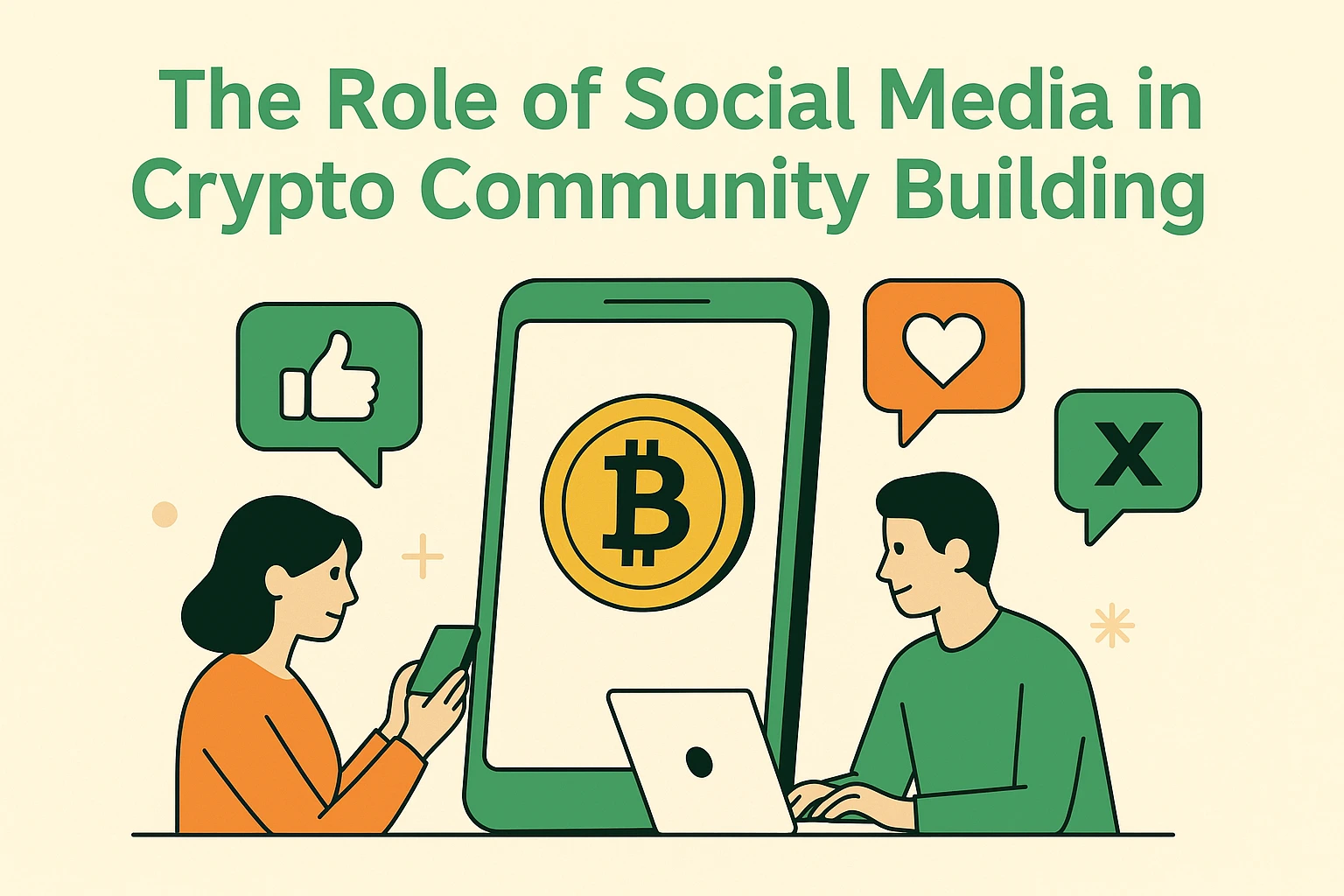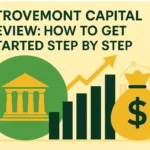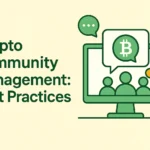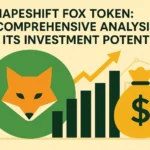In the rapidly evolving blockchain landscape, one element consistently separates successful projects from failed experiments: a strong, engaged community. As someone who’s been building in the crypto space since 2017, I’ve witnessed firsthand how crypto community building has transformed from an afterthought to perhaps the most crucial component of project development.
Social media platforms have become the primary battleground where these communities form, thrive, and occasionally collapse. The decentralized nature of Web3 makes these digital gathering spaces not just marketing channels but the actual infrastructure of many projects’ governance and operation.
This comprehensive guide explores how social media has redefined community building in crypto and provides actionable strategies for projects looking to cultivate meaningful connections with their supporters in 2025 and beyond.
Understanding Crypto Communities: More Than Just Holders
Before diving into strategies, it’s essential to understand what makes crypto community dynamics unique compared to traditional business-consumer relationships:
The Stakeholder Paradigm
In crypto, community members are often:
| Role | Traditional Business | Crypto Project |
|---|---|---|
| User | Uses product/service | Uses protocol/platform |
| Investor | Buys stocks/bonds | Holds tokens/NFTs |
| Advocate | Recommends to others | Markets on social media |
| Employee | Works for company | Contributes to DAO |
| Decision-maker | No input on company decisions | Votes on governance proposals |
This multifaceted relationship creates a fundamentally different dynamic that requires specialized crypto community building strategies.
The Four Pillars of Crypto Communities
Successful crypto communities typically demonstrate strength in four key areas:
- Information Sharing – Creating and distributing valuable content
- Engagement – Fostering meaningful interactions
- Governance – Enabling community decision-making
- Value Alignment – Ensuring shared goals and vision
Social media platforms provide the infrastructure for all four pillars, making them indispensable crypto community building tools.
Top Social Media Platforms for Crypto Community Building
Different platforms serve distinct functions in the crypto community building ecosystem:
Twitter/X: The Crypto Town Square
Strengths for Community Building
- Real-time information sharing
- Direct access to project leaders
- Wide reach beyond existing community
- Thread format for educational content
Effective Usage Strategies
- Regular project updates and milestones
- Thought leadership content from team members
- Community engagement through polls and questions
- Strategic use of hashtags and trending topics
Twitter remains essential for community building crypto projects despite recent changes. Its public nature makes it ideal for attracting new community members and maintaining visibility in the broader ecosystem.
Discord: The Community Headquarters
Strengths for Community Building
- Structured channels for different topics
- Direct communication with team members
- Community moderation tools
- Integration with Web3 tools (wallet verification, token gating)
Effective Usage Strategies
- Clear channel organization
- Active moderation team
- Regular community calls and AMA sessions
- Gamification and reward systems
Discord has become the de facto standard for day-to-day crypto community operations, offering a balance of accessibility and control that most projects find essential.
Telegram: The Global Connector
Strengths for Community Building
- Widespread global adoption
- Simple interface for newcomers
- Broadcast channels for announcements
- Group chat for community discussions
Effective Usage Strategies
- Multilingual support
- Clear community guidelines
- Bot integration for moderation
- Regular engagement from project team
Telegram remains crucial for crypto community building in regions where Discord adoption is lower, particularly in Asia and Eastern Europe.
Reddit: The Discussion Forum
Strengths for Community Building
- In-depth discussion format
- Community-driven content curation
- Long-form content
- Subreddit customization
Effective Usage Strategies
- Regular “Ask Me Anything” sessions
- Community rewards for valuable contributions
- Educational content series
- Technical discussion threads
Reddit provides depth that other platforms lack, making it valuable for projects emphasizing technical innovation and detailed governance discussions.
Strategic Framework for Crypto Community Building
Effective crypto community building strategies follow a clear progression:
1. Foundation Phase: Establishing Community Basics
During this initial stage, focus on:
- Defining Community Values
- What principles guide your project?
- What behaviors are encouraged or discouraged?
- What unique perspective does your project offer?
- Setting Clear Expectations
- Realistic roadmap communication
- Transparent tokenomics explanations
- Honest discussion of challenges and risks
- Creating Essential Infrastructure
- Social media account setup
- Community guidelines documentation
- Moderation team recruitment
This foundation establishes the parameters for healthy community building in crypto.
2. Growth Phase: Expanding Community Reach
As your community begins to form, implement these growth strategies:
- Content Marketing Strategy
- Educational material about your technology
- Ecosystem analysis and thought leadership
- Technical explainers and tutorials
- Incentivized Participation Programs
- Ambassador programs
- Content creation rewards
- Bug bounties and technical contributions
- Strategic Partnerships
- Collaborative events with aligned projects
- Joint AMAs with complementary communities
- Cross-promotion with ecosystem partners
These efforts should focus on attracting participants who share your project’s values and vision.
3. Engagement Phase: Deepening Community Connections
Once you’ve established a core community, focus on strengthening relationships:
- Regular Community Rituals
- Weekly community calls
- Monthly development updates
- Quarterly roadmap reviews
- Governance Participation
- Education about governance mechanisms
- Facilitation of proposal discussions
- Transparent decision-making processes
- Recognition and Reward Systems
- Acknowledgment of community contributions
- Token incentives for participation
- Non-monetary recognition programs
This phase transforms casual supporters into committed community members.
4. Evolution Phase: Community-Led Growth
The most mature communities begin to self-organize and drive project direction:
- Decentralized Working Groups
- Community-led development initiatives
- Special interest groups around specific features
- Regional/language-specific subcommunities
- Community-Driven Content
- User-generated educational materials
- Community-hosted events and spaces
- Collaborative marketing initiatives
- Ecosystem Development
- Support for builders creating on your platform
- Grants programs administered by community
- Incubation of complementary projects
At this stage, the community becomes a self-sustaining ecosystem that drives project growth.
Advanced Crypto Community Building Tools and Techniques
Beyond basic social media platforms, several specialized crypto community building tools have emerged:
Token-Gated Communities
- Benefits
- Ensures skin-in-the-game participation
- Creates exclusivity and belonging
- Aligns financial incentives with participation
- Implementation Options
- Guild.xyz for cross-platform token gating
- Collab.Land for Discord and Telegram integration
- Custom solutions for project-specific needs
These tools create layered community experiences based on commitment level.
On-Chain Reputation Systems
- Benefits
- Recognizes consistent contributors
- Creates transparent contribution history
- Builds portable reputation across ecosystem
- Implementation Options
- Lens Protocol for social reputation
- Gitcoin Passport for verified identity
- Custom reputation tokens or badges
These systems help identify and reward valuable community members.
Community Analytics Platforms
- Benefits
- Data-driven community management
- Early identification of issues or opportunities
- Measurement of engagement initiatives
- Implementation Options
- Orbit for relationship-focused analytics
- Common Room for cross-platform insights
- Dune Analytics for on-chain community metrics
Analytics enable more targeted and effective crypto community building strategies.
Common Challenges in Crypto Community Building
Even with the best tools and intentions, crypto community building faces significant challenges:
Market Volatility Impact
Price fluctuations dramatically affect community sentiment. Strategies to address this include:
- Focus on Long-Term Vision
- Consistent messaging about fundamental value
- Educational content about market cycles
- Highlighting development progress regardless of price
- Transparent Communication During Downturns
- Honest assessment of challenges
- Continued building visibility
- Community support initiatives
Balancing Decentralization and Direction
The tension between community ownership and project leadership requires:
- Clear Governance Frameworks
- Defined processes for proposals and voting
- Transparent decision-making criteria
- Progressive decentralization roadmap
- Balanced Leadership Approach
- Active but not controlling team presence
- Guidance without domination
- Supporting community initiatives
Managing Information Asymmetry
The technical complexity of crypto creates knowledge gaps that must be addressed through:
- Layered Educational Content
- Entry-level material for newcomers
- Advanced guides for experienced members
- Technical documentation for developers
- Peer Learning Systems
- Mentorship programs
- Question-and-answer channels
- Community-taught workshops
Measuring Success in Crypto Community Building
Effective crypto community building requires clear metrics for evaluation:
Quantitative Metrics
| Category | Metrics | Significance |
|---|---|---|
| Growth | Follower/member count | Basic community size |
| New member rate | Acquisition effectiveness | |
| Retention rate | Community satisfaction | |
| Engagement | Active user percentage | Community health |
| Message frequency | Conversation activity | |
| Reaction/response rates | Content resonance | |
| Governance | Proposal submission rate | Community initiative |
| Voting participation | Governance engagement | |
| Implementation completion | Execution effectiveness | |
| Development | Contributor count | Builder attraction |
| Pull request/issue activity | Technical involvement | |
| Third-party integrations | Ecosystem growth |
Qualitative Assessment
Beyond numbers, evaluate:
- Community Sentiment
- General tone of discussions
- Response to challenges
- Expression of shared values
- Content Quality
- Depth of technical discussions
- Helpfulness toward newcomers
- Constructive criticism vs. complaints
- Leadership Emergence
- Community members taking initiative
- Peer recognition systems
- Self-organization patterns
The most successful communities excel in both quantitative and qualitative dimensions.
Case Studies: Successful Crypto Community Building
Case Study 1: Ethereum’s Multi-Platform Approach
Ethereum’s community strategy demonstrates effective crypto community building across multiple channels:
- Differentiated Platform Usage
- Twitter for announcements and thought leadership
- Reddit for technical discussions and governance
- Discord for developer coordination
- Local Telegram groups for regional communities
- Key Success Factors
- Clear separation of technical and general discussions
- Strong educational resources
- Support for independent community initiatives
- Transparent development processes
Case Study 2: Lens Protocol’s Creator-Centric Approach
Lens demonstrates innovative community building crypto strategies focused on creators:
- Creator-First Philosophy
- Tools and support for content creators
- Amplification of community-created content
- Delegation of official marketing to community
- Key Success Factors
- Authentic relationship building
- Technical support for creators
- Recognition and reward systems
- Community-led growth initiatives
Conclusion: The Future of Crypto Community Building
As we move deeper into the Web3 era, crypto community building will continue evolving beyond traditional social media frameworks. The most successful projects will blend:
- Decentralized Ownership – True stakeholder participation
- Cross-Platform Integration – Seamless community experience
- Value-Driven Engagement – Focus on meaningful contribution
- On-Chain Governance – Transparent decision-making
- Real-World Connection – Bridging digital and physical communities
The communities that master these elements will not just support projects—they will become the projects themselves, embodying the decentralized ethos at the heart of the crypto revolution.
For founders, developers, and marketers in the space, viewing community not as a marketing channel but as your core product may be the single most important paradigm shift for long-term success. The projects that internalize this understanding will be the ones that define the next generation of Web3.
FAQ: Crypto Community Building
Q: What’s the most important social platform for crypto community building in 2025?
A: There isn’t a single “most important” platform. Discord typically serves as the operational hub, Twitter provides visibility and recruitment, Telegram offers global reach, and Reddit supports in-depth discussion. The optimal mix depends on your project’s specific needs and target community.
Q: How do you balance community input with project direction?
A: Successful projects create clear frameworks for community participation while maintaining core vision alignment. This often involves separating decisions into categories: some fully community-governed, others guided by the core team, with transparent reasoning for each approach.
Q: How can smaller projects compete with established communities?
A: Focus on creating deeper value for a specific niche rather than competing for general attention. Smaller communities can offer more personal connections, specialized knowledge, and targeted benefits that larger communities cannot match.
Q: How do you handle toxic community members?
A: Establish clear community guidelines, enforce them consistently, provide warnings for minor infractions, and remove persistent violators. Most importantly, cultivate a positive culture where the community self-regulates negative behavior.
Q: What’s the appropriate budget allocation for community building?
A: Successful projects typically allocate 15-30% of their operational budget to community development, including dedicated community managers, tools, events, and incentive programs. This investment often delivers the highest ROI of any operational expense.

Alex R. Bennett is a cryptocurrency analyst and content strategist with over 7 years of experience in digital assets, DeFi, and blockchain-based investing. After navigating the volatile crypto markets since 2017, Alex launched CoinBuyingTips to help everyday investors make smarter, research-backed decisions.
A strong advocate for transparency and independent research, Alex has written for several industry publications and is known for turning complex tokenomics into clear, actionable insights. When not diving into token whitepapers, Alex hosts webinars and publishes deep-dive reviews that help demystify crypto for the mainstream audience.






